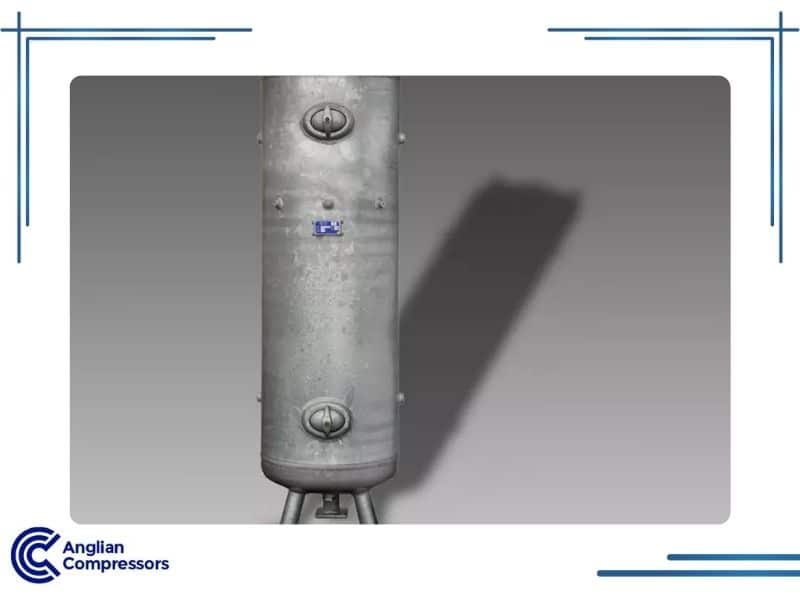Why You Need an Air Compressor Aftercooler
Moisture in compressed air lines is one of the most common causes of product defects and equipment failures, and fitting an aftercooler is the first step in preventing them. This guide explains why an air compressor aftercooler is not merely an optional accessory but a fundamental component for ensuring system reliability, energy efficiency, and product quality.
How Your Compressor Generates Water
Every air compressor is also a water generator, and that’s not a design flaw but rather a consequence of physics. When atmospheric air is drawn into a compressor and pressurised, its temperature skyrockets. This “heat of compression” can cause discharge air temperatures to reach 93°C in oil-injected models and over 177°C in oil-free units, a key difference explained in our guide on Oil vs Oil-Free Air Compressors.
Hot air can hold significantly more water vapour than cool air, and as this hot, saturated compressed air travels into cooler air receivers and pipework, its temperature plummets, and the water vapour is forced to condense into liquid water. A 100 kW compressor operating in typical UK conditions can release approximately 85 litres of water into the system during a single 8-hour shift, and, without an aftercooler, this water would spread throughout your distribution system.
Problems Caused by Hot, Wet Air
If left untreated, hot, moisture-laden compressed air not only wastes energy but also damages your infrastructure, equipment, and products.
System-Wide Corrosion and Leaks
Liquid water is the primary cause of rust and scale buildup inside steel air receivers and pipework, and when these particles dislodge, they pollute your air supply, fouling filters and plugging valves. The corrosion caused by liquid water also thins pipes and creates air leaks that can waste 20-30% of your compressor’s total output, which causes it to run longer to produce the amount required, increasing your energy consumption.
Damage to Downstream Equipment
Hot, wet, dirty air is the enemy of your equipment:
- Pneumatic Tools & Cylinders: Heat causes rubber seals to deteriorate, and water removes lubricants, resulting in slow responsiveness and early wear-out.
- Air Dryers: Most users make the mistake of thinking a dryer is all they need, but refrigerated and desiccant dryers are designed to accept air at a temperature typically around 38°C. Sending 93°C air directly from a compressor will overwhelm the dryer, rendering it ineffective and potentially causing damage. An aftercooler is a crucial pre-treatment that enables your dryer to work efficiently by receiving air at the intended temperature. Consider looking into Compressed Air Dryers to complete your air treatment setup.
- Filters: Coalescing filters are designed to remove fine aerosols, not bulk liquid, so they become saturated almost instantly by hot, wet air, causing severe pressure drops and allowing liquid to pass downstream in the system.
Compromised Product Quality and Compliance
In many industries, the quality of air is a direct contributor to the quality of the final product, as well as regulatory compliance.
- Automotive & Painting: Humid air entering your paint booth can cause defects such as “fish eyes” and “blushing”, requiring you to strip and redo entire jobs to meet quality standards.
- Food & Beverage: Warm, moist air on the inside of pipes is a breeding ground for bacteria, which risks product spoilage, and leaves the task of achieving food safety standards such as ISO 22000 and compressed air purity classes in ISO 8573-1, impossible.
- Pharmaceutical & Medical: Air contaminants can ruin sterile environments and sensitive products, meaning you are unable to meet strict compliance requirements; HTM 2022 for dental compressed air requires a specific Pressure Dew Point (PDP) to ensure the air is dry.
If you see any of these symptoms in your products or facility, it’s time to Troubleshoot Moisture Issues within your system.

How an Aftercooler Works
Positioned immediately after the compressor outlet, an aftercooler is a heat exchanger that acts as the first line of defence, performing two critical functions:
- It uses a cooling medium (ambient air or water) to reduce the temperature of the hot compressed air drastically.
- This temperature drop forces up to 80% of the water vapour to condense into liquid.
This is why every modern compressed air system, whether rotary screw or piston, should include an aftercooler as a standard feature.
An aftercooler isn’t a complete treatment system by itself; it is part of a set of three components:
- Aftercoolers chill the air, allowing the water to condense.
- Water Separators spin liquid water out of the air stream using centrifugal force.
- Automatic Drains discharge all of the liquid that has been collected from your system.
If your automatic drain becomes clogged or fails, your system’s performance will suffer, so ensure you adhere to proper condensate management.
Air-Cooled or Water-Cooled Aftercoolers?
There are two types of aftercoolers, air-cooled and water-cooled, and each has its own advantages and disadvantages.
- Air-Cooled Aftercoolers use a fan to force ambient air to flow over finned tubes that contain your hot compressed air. Air-cooled aftercoolers are easy to install and less expensive to purchase than water-cooled ones, but they are less effective in cooling compressed air in a hot environment.
- Water-Cooled Aftercoolers direct water to flow through a shell-and-tube heat exchanger to cool your compressed air. Water-cooled aftercoolers can provide more uniform and efficient cooling than air-cooled ones because the cooling temperature remains constant, regardless of the surrounding environment. Water-cooled aftercoolers also make it easier to recover the heat from your compressed air system to be used elsewhere.
The Business Case for Aftercoolers
Selecting and purchasing the right aftercooler is a low-risk investment that will reap tangible returns for your business; by attacking the source of moisture in your system, you can unlock significant operational benefits and the critical issue of overheating.
Improving System Reliability and Equipment Lifespan
Aftercoolers remove two primary factors that contribute to corrosion and thermal stress by providing cool, dry air. This preserves your entire system, from air receiver to tools, and reduces the incidence of unscheduled downtime as well as maximising the working life of every component.
Boosting Energy Efficiency and Lowering Operating Costs
Installing an aftercooler in your air compression system will almost certainly result in significant energy savings; by pre-cooling the air and extracting most of the moisture, aftercoolers radically reduce the demand on your downstream air dryers, lowering their energy usage.
UK regulations require businesses to handle condensate safely under environmental law. ISO 8573-1 for compressed air purity, along with the Health and Safety Executive’s (HSE) recommendations, make aftercoolers a legal necessity for compliance in industries such as food & beverage production, as well as healthcare & beauty sectors. Using an aftercooler can aid in achieving Net Zero and Climate Change Levy efficiency targets.
The Anglian Compressors Advantage: A Trusted Branch of Atlas Copco
We are an authorised Atlas Copco distributor, having held this position for over 37 years, since 1977. This means we can advise you and supply technically superior compressed air cooling.
- Many of our competitors sell ‘isolated’ aftercoolers, which are available separately, but Atlas Copco supplies them as part of a compressor package, ensuring you get the right size, have simple installation, and higher energy efficiency. SMARTLINK connectivity and energy recovery features further differentiate their exceptional systems.
Our team, based in Peterborough and serving East Anglia and the Midlands, provides comprehensive system design, professional installation, a preventative maintenance plan, and clear after-cooler maintenance tips to ensure your air treatment system performs reliably and efficiently. We also conduct air quality testing and audits to identify and solve your system’s moisture problems.
Don’t risk expensive system downtime. Call Anglian Compressors, a branch of Atlas Copco, today to arrange a system audit or receive a free, no-obligation aftercooler recommendation.
Frequently Asked Questions
What do air compressor aftercoolers do?
An aftercooler is a heat exchanger that directly cools the hot air exiting your air compressor. This cooling process condenses the majority of the water vapour in the air into a liquid, allowing it to be easily removed by a separator and drained before it can contaminate your pipework and equipment.
Do I need an aftercooler if I already have an air dryer in place?
Yes, absolutely! Aftercoolers and Air dryers handle different stages of the same job; aftercoolers remove up to 80% of the bulk liquid water, preconditioning the air to a temperature that dryers can deal with. If you don’t use an aftercooler, the hot, saturated air will swamp your dryer and render it useless.
What’s the difference between an aftercooler and an intercooler?
Both are heat exchangers, but are mounted in different places for different reasons; aftercoolers are placed after the last stage of compression and cool the air before it enters your air receiver. Intercoolers are used on multi-stage compressors and are mounted between compression stages to improve compression efficiency.
How does an aftercooler improve energy efficiency?
In addition to protecting your compressed air system, aftercoolers enhance system efficiency in two ways: they significantly reduce the thermal and moisture load on your air dryer, resulting in your dryer using less energy, and, because an aftercooler prevents internal pipe corrosion, it helps your system maintain a consistent pressure. As a result, your compressor will not have to work harder (and use more energy) to overcome pressure restrictions.
Are Atlas Copco aftercoolers superior to those of other brands?
Atlas Copco aftercoolers are engineered for high efficiency and minimal pressure drop, but the main benefit is system integration. In an Atlas Copco compressor package, the aftercooler is sized and selected to be perfectly matched to your compressor’s performance, ensuring maximum reliability and efficiency. This approach, along with other integrated features such as SMARTLINK monitoring, provides performance advantages that are difficult to achieve with separate units.


